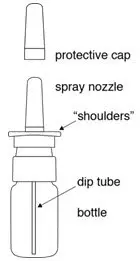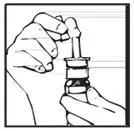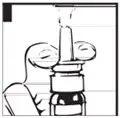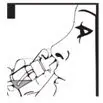Drug Detail:Ddavp (nasal) (Desmopressin (nasal) [ dez-mo-press-in ])
Drug Class: Antidiuretic hormones
Highlights of Prescribing Information
DDAVP (desmopressin acetate) nasal spray
Initial U.S. Approval: 1978
Indications and Usage for DDAVP Nasal Spray
DDAVP Nasal Spray is a vasopressin analog indicated as antidiuretic replacement therapy in the management of central diabetes insipidus for adults and pediatric patients 4 years of age and older (1)
Limitations of Use:
DDAVP Nasal Spray is not indicated for:
- Treatment of nephrogenic diabetes insipidus (1)
- Treatment of primary nocturnal enuresis (1, 5.1)
- Use in patients with conditions that compromise intranasal route of administration (1, 5.2)
- Use in patients with an impaired level of consciousness (1)
- Use in patients requiring doses less than 10 mcg or doses that are not multiples of 10 mcg (1,3)
DDAVP Nasal Spray Dosage and Administration
- For intranasal use only (2.1)
- Instruct patients to prime pump prior to use (2.1)
- Adults: 10 mcg to 40 mcg daily (either as a single dose or divided into two or three daily doses) (2.2)
- Pediatrics: 10 mcg once daily into one nostril up to 30 mcg once daily (or 30 mcg divided as 20 mcg during the morning and 10 mcg at night) (2.2)
- See the Full Prescribing Information for recommendations for switching between desmopressin acetate formulations (2.3)
Dosage Forms and Strengths
Nasal Spray: 10 mcg per 0.1 mL spray, available in a 5 mL bottle with spray pump delivering 50 sprays (3)
Contraindications
- Known hypersensitivity to desmopressin acetate or to any of the components of DDAVP Nasal Spray (4, 6)
- Patients with renal impairment (creatinine clearance below 50 mL/min) (4, 8.6, 12.3)
- Hyponatremia or a history of hyponatremia (4, 5.1)
Warnings and Precautions
- Hyponatremia: Instruct patients about proper fluid restriction and monitor serum sodium as needed (2.1, 5.1)
- Altered Absorption in Patients with Nasal Mucosa Abnormalities: May occur with chronic administration, and require use of other formulations instead (5.2)
Adverse Reactions/Side Effects
Adverse reactions that have been identified in patients administered DDAVP Nasal Spray are headache, nasal congestion, rhinitis, nosebleed, sore throat, cough, upper respiratory infections, nausea, flushing, and mild abdominal cramps (6)
To report SUSPECTED ADVERSE REACTIONS, contact Ferring Pharmaceuticals Inc. at 1-888-FERRING (1-888-337-7464) or FDA at 1-800-FDA-1088 or www.fda.gov/medwatch.
Drug Interactions
- Drugs that Increase Risk of Hyponatremia: Requires more frequent monitoring of serum sodium (7.1)
- Other Vasocontrictors: Concomitant use may elevate blood pressure and require a reduction in DDAVP Nasal Spray dosage (7.2)
Use In Specific Populations
- Pediatric Use: Use requires careful fluid intake restriction to prevent hyponatremia with water intoxication (5.1, 8.4)
- Geriatric Use: Carefully monitor renal function; restrict fluid intake to prevent hyponatremia with water intoxication (5.1, 8.5)
See 17 for PATIENT COUNSELING INFORMATION and FDA-approved patient labeling.
Revised: 10/2020
Related/similar drugs
hydrochlorothiazide, desmopressin, Microzide, vasopressin, DDAVPFull Prescribing Information
1. Indications and Usage for DDAVP Nasal Spray
DDAVP Nasal Spray is indicated as antidiuretic replacement therapy in the management of central diabetes insipidus in adults and pediatric patients 4 years of age and older.
2. DDAVP Nasal Spray Dosage and Administration
2.1 Important Administration Instructions
Administer DDAVP Nasal Spray by intranasal use only. Instruct patients about appropriate fluid restriction during DDAVP Nasal Spray treatment [see Warnings and Precautions (5.1)].
Must prime the spray pump prior to the first use. Instruct patients to:
- Prime pump by pressing down on pump four times (if the spray pump is not used for one week, re-prime the pump by pressing down on the pump once).
- Discard DDAVP Nasal Spray after 50 sprays since the amount delivered thereafter may be substantially less than the recommended dosage.
2.2 Recommended Dosage
The use of DDAVP Nasal Spray is not indicated for patients who require less than 10 mcg doses or doses that are not multiples of 10 mcg because the spray pump can only deliver doses of 10 mcg [see Indications and Usage (1)]. If other doses are required, use another desmopressin acetate product.
Individualize the dosage of DDAVP Nasal Spray for each patient with particular attention in pediatric and elderly patients and adjust according to the diurnal pattern of response to limit nocturia and to ensure fluid intake with respect to urine output is not excessive [see Warnings and Precautions (5.1)]. Monitor continued response to DDAVP Nasal Spray by urine volume and osmolality to ensure adequate diuresis to limit the risk of hyponatremia, and include measurements of serum sodium and plasma osmolality as needed.
2.3 Switching Between Desmopressin Acetate Formulations
When switching from the desmopressin acetate injection to DDAVP Nasal Spray, administer 10 times the amount of desmopressin acetate, rounding down to the nearest 10 mcg.
When switching from the desmopressin acetate tablets to DDAVP Nasal Spray individual dose titration is required because intranasal desmopressin is approximately 10 to 40 fold more potent than oral (tablet) desmopressin.
3. Dosage Forms and Strengths
DDAVP Nasal Spray pump delivers 10 mcg (0.1 mL) of desmopressin acetate per spray.
DDAVP Nasal Spray is available as a 5 mL bottle with spray pump delivering 50 sprays.
4. Contraindications
DDAVP Nasal Spray is contraindicated in patients with:
- Known hypersensitivity to desmopressin acetate or to any of the components of DDAVP Nasal Spray. Severe allergic reactions and anaphylaxis have been reported [see Adverse Reactions (6)].
- Renal impairment defined as estimated creatinine clearance (CLcr) by Cockcroft-Gault equation less than 50 mL/min [see Use in Specific Populations (8.6) and Clinical Pharmacology (12.3)].
- Hyponatremia or a history of hyponatremia [see Warnings and Precautions (5.1)].
5. Warnings and Precautions
5.1 Hyponatremia
Excessive fluid intake when urine output is limited by the antidiuretic effect of desmopressin may lead to water intoxication with hyponatremia. Cases of hyponatremia have been reported from postmarketing experience in patients treated with desmopressin acetate. Unless properly diagnosed and treated, hyponatremia can be fatal.
All patients receiving DDAVP Nasal Spray should be observed for the following signs or symptoms associated with hyponatremia: headache, nausea/vomiting, decreased serum sodium, weight gain, restlessness, fatigue, lethargy, disorientation, depressed reflexes, loss appetite, irritability, muscle weakness, muscle spasms or cramps and abnormal mental status such as hallucinations, decreased consciousness, and confusion. Severe symptoms due to an extreme decrease in serum sodium and plasma osmolality may include one or a combination of the following: seizure, coma, and/or respiratory arrest.
In order to decrease the risk of water intoxication with hyponatremia, fluid restriction is recommended. Careful fluid intake restriction is particularly important in pediatric and geriatric patients because these patients are at greater risk of developing hyponatremia [see Use in Specific Populations (8.4, 8.5)]. More frequent monitoring of serum sodium levels is recommended in the following patients: those with conditions associated with fluid and electrolyte imbalance, such as cystic fibrosis, heart failure, renal disorders, habitual or psychogenic polydipsia or those taking concomitant drugs that may cause hyponatremia [see Drug Interactions (7.1)].
DDAVP Nasal Spray is not an indicated formulation for the treatment of primary nocturnal enuresis due to a higher risk of hyponatremia and hyponatremic convulsions with the use of the nasal spray formulation compared to desmopressin tablets seen in postmarketing reports [see Indications and Usage (1)].
5.2 Altered Absorption in Patients with Nasal Mucosa Abnormalities
Chronic administration of DDAVP Nasal Spray may result in changes to nasal mucosa. Nasal mucosa abnormalities (such as scarring and edema) due to chronic administration, or due to other causes (nasal blockage, nasal mucosal atrophy, severe atrophic rhinitis, recent nasal surgery such as transsphenoidal hypophysectomy) may cause erratic, unreliable absorption. Avoid use of DDAVP Nasal Spray in such patients [see Indications and Usage (1)] and consider use of other formulations of desmopressin acetate given by other routes of administration.
6. Adverse Reactions/Side Effects
The following serious reactions are described below and elsewhere in the labeling:
- Hyponatremia [see Warnings and Precautions (5.1)].
- Altered Absorption in Patients with Changes in Nasal Mucosa [see Warnings and Precautions (5.2)].
The following adverse reactions have been identified during post-approval use of desmopressin acetate. Because these reactions are reported voluntarily from a population of uncertain size, it is not always possible to reliably estimate their frequency or establish a causal relationship to drug exposure:
Increase in blood pressure, headache, nasal congestion, rhinitis, nosebleed, sore throat, cough, upper respiratory infections, nausea, flushing, and abdominal cramps.
Water intoxication with hyponatremia
Hyponatremic convulsions associated with concomitant use of the following medications: oxybutinin and imipramine [see Drug Interactions (7.1)].
Severe allergic reactions and anaphylaxis [see Contraindications (4)]
7. Drug Interactions
7.1 Other Drugs that may Increase Risk of Hyponatremia
The concomitant administration of DDAVP Nasal Spray with other drugs that may increase the risk of water intoxication with hyponatremia, (e.g., tricyclic antidepressants, selective serotonin re-uptake inhibitors, chlorpromazine, opiate analgesics, NSAIDs, lamotrigine, oxybutynin and carbamazepine) requires more frequent serum sodium monitoring [see Warnings and Precautions (5.1) and Adverse Reactions (6)].
8. Use In Specific Populations
8.2 Lactation
Data
A trial was conducted in six healthy lactating women, at greater than 4 months postpartum, to evaluate intranasal administration of 300 mcg single dose of another desmopressin product (7.5 times the recommended adult dose of DDAVP Nasal Spray). Samples of maternal plasma and breastmilk were obtained at 0, 30, 60, 120, 240, 360 and 480 min after the drug administration. At 8 hours after dose intake, the levels in the milk ranged between 4.16 and 101 pg/ml, and the plasma levels ranged between 40 and 242 pg/ml. The total amount of desmopressin present in the milk over the 8 hours ranged between 491 pg and 16 ng, which corresponds to 0.0001 - 0.005% of the administered dose to the breastfeeding mother.
8.4 Pediatric Use
DDAVP Nasal Spray is indicated as antidiuretic replacement therapy in the management of central diabetes insipidus in pediatric patients 4 years of age and older. DDAVP Nasal Spray is not indicated in pediatric patients less than 4 years of age.
Use of DDAVP Nasal Spray in pediatric patients 4 years of age and older is supported by evidence from adults and pediatric patients with central diabetes insipidus. Use in pediatric patients requires careful fluid intake restriction to prevent possible water intoxication with hyponatremia [see Warnings and Precautions (5.1)].
8.5 Geriatric Use
Clinical studies of DDAVP Nasal Spray did not include sufficient numbers of subjects aged 65 and over to determine whether they respond differently from younger subjects. In general, dose selection for an elderly patient should be cautious, usually starting at a low end of the dosing range, reflecting the greater frequency of decreased hepatic, renal, or cardiac function, and of concomitant disease or drug therapy.
Because elderly patients are more likely to have renal impairment, care should be taken in dose selection, and monitoring renal function is recommended [see Contraindications (4), Use in Specific Populations (8.6)].
Use of DDAVP Nasal Spray in geriatric patients requires careful fluid intake restriction to prevent possible water intoxication with hyponatremia [see Warnings and Precautions (5.1)].
8.6 Renal Impairment
Desmopressin acetate is substantially excreted by the kidney, and the risk of adverse reactions may be greater in patients with renal impairment than patients with normal renal function. DDAVP Nasal Spray is contraindicated in patients with estimated CLcr by Cockcroft-Gault equation less than 50 mL/min [see Clinical Pharmacology (12.1, 12.3), Contraindications (4)].
10. Overdosage
Signs of desmopressin acetate overdosage may include confusion, drowsiness, continuing headache, problems with passing urine, and rapid weight gain due to fluid retention [see Warnings and Precautions (5.1)]. In case of overdosage, reduce the dosage, decrease the frequency of administration, or discontinue DDAVP Nasal Spray. There is no known specific antidote for desmopressin acetate.
11. DDAVP Nasal Spray Description
DDAVP Nasal Spray is a vasopressin analogue of the natural pituitary hormone 8-arginine vasopressin (ADH), an antidiuretic hormone affecting renal water conservation. It is chemically defined as follows:
Molecular weight: 1183.34
Empirical formula: C46H64N14O12S2∙C2H4O2∙3H2O

1-(3-mercaptopropionic acid)-8-D-arginine vasopressin monoacetate (salt) trihydrate.
DDAVP Nasal Spray is an aqueous solution for intranasal use. Each mL contains:
- Desmopressin acetate 0.1 mg
- Sodium chloride 7.5 mg
- Citric acid monohydrate 1.7 mg
- Disodium phosphate dihydrate 3 mg
- Benzalkonium chloride solution (50%) 0.2 mg
12. DDAVP Nasal Spray - Clinical Pharmacology
12.1 Mechanism of Action
The antidiuretic effects of desmopressin are mediated by stimulation of vasopressin 2 (V2) receptors, thereby increasing water re-absorption in the kidney, and hence reducing urine production. Desmopressin is a replacement hormone for antidiuretic hormone in the treatment of central diabetes insipidus. The change in structure of arginine vasopressin to desmopressin acetate resulted in a decreased vasopressor action and decreased actions on visceral smooth muscle relative to the enhanced antidiuretic activity, so that clinically effective antidiuretic doses were usually below threshold levels for effects on vascular or visceral smooth muscle.
12.2 Pharmacodynamics
The use of DDAVP Nasal Spray in patients with central diabetes insipidus reduces urinary output, increases urine osmolality, and decreases plasma osmolality.
16. How is DDAVP Nasal Spray supplied
17. Patient Counseling Information
Advise the patient to read the FDA-approved patient labeling (Patient Information and Instructions for Use)
Instructions for Use
DDAVP
Nasal Spray, 10 mcg per 0.1 mL
For Intranasal Use Only
Read these instructions before using DDAVP Nasal Spray, and each time you get a refill. There may be new information. This information does not take the place of talking to your healthcare provider about your medical condition or treatment.
Children should be helped by an adult when using DDAVP Nasal Spray, to make sure the right amount of medicine is used.
The parts of your DDAVP Nasal Spray pump (see Figure A):
Priming your DDAVP Nasal Spray:
Your DDAVP Nasal Spray pump must be primed before you use it for the first time.
- Remove the protective cap (see Figure B).
- Press down on the shoulders at the top of your DDAVP Nasal Spray pump 4 times. Hold the spray tip away from your face and eyes (see Figure C).
- After your DDAVP Nasal Spray pump is primed, it will spray 10 micrograms (1 dose) of medicine each time it is pressed.
Using your DDAVP Nasal Spray:
Step 1. Remove the protective cap.
Step 2. To make sure you get the right dose of medicine tilt your DDAVP Nasal Spray pump so the dip tube inside the bottle draws the medicine up from the deepest part of the medicine inside the bottle (see Figures D and E).
Step 3. Put the spray nozzle tip of your DDAVP Nasal Spray into your nostril and press the spray pump 1 time for 1 dose. (see Figure F). If 2 doses are prescribed, spray each nostril 1 time.
Step 4. Put the protective cap back on the spray nozzle tip when you finish using your DDAVP Nasal Spray.
Keeping track of your Nasal Sprays:
- Use the check-off chart to help you keep track of your DDAVP Nasal Sprays used (see Figure G).
| DDAVP Nasal Spray |
|---|
| 50-Spray Check-off Chart |
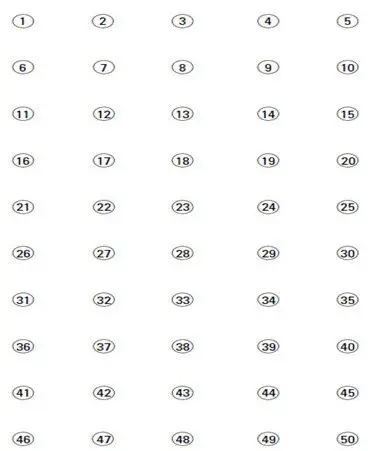 |
| Figure G |
- Keep this chart with your DDAVP Nasal Spray or put it someplace where you can easily get it.
- Check off number 1 on the chart with your first dose of DDAVP Nasal Spray. Check off the numbers after each use of your DDAVP Nasal Spray. If your healthcare provider prescribed a 2-spray dose, then 2 numbers should be checked off.
- Your DDAVP Nasal Spray holds 50 sprays with the right amount of medicine in each spray.
- If any medicine is left in your DDAVP Nasal Spray after 50 sprays, do not use it. You may not get the right amount of medicine.
- Throw away your DDAVP Nasal Spray after 50 sprays.
- Do not count the priming sprays. Your DDAVP Nasal Spray has been filled with extra medicine for your priming sprays.
- Do not try to remove any medicine from your DDAVP Nasal Spray pump and place it in another bottle.
How should I store DDAVP Nasal Spray?
- Store DDAVP Nasal Spray at room temperature between 68°F to 77°F (20°C to 25°C).
- Store DDAVP Nasal Spray standing upright.
This Instructions for Use has been approved by the U.S. Food and Drug Administration.
Manufactured for:
Ferring Pharmaceuticals Inc.
Parsippany, NJ 07054 USA
Origin Sweden
Rev. 09/18
XXXXXXXXXX
| DDAVP
desmopressin acetate spray |
||||||||||||||||||||
|
||||||||||||||||||||
|
||||||||||||||||||||
|
||||||||||||||||||||
|
||||||||||||||||||||
|
||||||||||||||||||||
| Labeler - Ferring Pharmaceuticals Inc. (103722955) |
| Establishment | |||
| Name | Address | ID/FEI | Business Operations |
|---|---|---|---|
| Ferring GmbH | 328609615 | MANUFACTURE(55566-2500) , ANALYSIS(55566-2500) , PACK(55566-2500) , LABEL(55566-2500) | |
| Establishment | |||
| Name | Address | ID/FEI | Business Operations |
|---|---|---|---|
| Rechon Life Science AB | 775207769 | MANUFACTURE(55566-2500) , ANALYSIS(55566-2500) , PACK(55566-2500) | |
| Establishment | |||
| Name | Address | ID/FEI | Business Operations |
|---|---|---|---|
| Ferring International Center SA | 481210362 | PACK(55566-2500) | |
| Establishment | |||
| Name | Address | ID/FEI | Business Operations |
|---|---|---|---|
| PolyPeptide Laboratories (Sweden) AB | 356580779 | API MANUFACTURE(55566-2500) , ANALYSIS(55566-2500) | |




